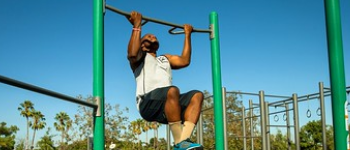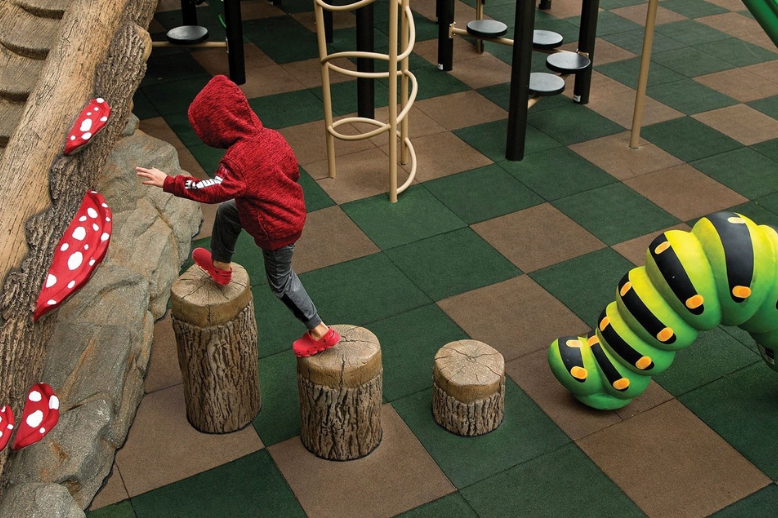-
Play

Inclusive playgrounds are designed for all ages and abilities.
-
Site

Upgrade your park or playground with smart, self-cleaning bathrooms
-
Sport

Outdoor fitness is exercise on another level.
-
Studio

Upgrade your park or playground with smart, self-cleaning bathrooms
-
Resources

Upgrade your park or playground with smart, self-cleaning bathrooms
-
About Us

Upgrade your park or playground with smart, self-cleaning bathrooms
-
Contact

Upgrade your park or playground with smart, self-cleaning bathrooms
Playground Safety Surfacing 101 Which Surfacing is Best?

Table of Contents
Want to Save This Guide for Later?
Download a free PDF by filling out the form below.
.png)
SECTION 1 What is Playground Safety Surfacing?

Playground surfacing is what lies beneath your play equipment.
The best solution is a shock-absorbing material such as wood chips or rubber. Among the worst choices are concrete, asphalt, dirt and grass. Let's dive in and talk about the importance of having good materials when it comes to designing or building your playground.
SECTION 2 Why is it Important to Have Safety Surfacing?

They’re an exciting place to be! As such, children need to feel safe, and playground surfaces play a big part in this… mostly because children fall down … a lot. In fact, around 200,000 children visit the emergency room every year due to playground injuries, according to the CDC (Centers for Disease Control and Prevention).
It’s natural for kids to be so absorbed in play that they forget to be careful and inevitably fall. This is where safety surfacing matters. The right material will absorb the shock of their fall, dampening it and avoiding costly catastrophes.
Playground Safety Standards
To ensure the safety of everyone on the playground, it is important to recognize hazards, common causes of injury, and how to mitigate situations. U.S. Consumer Product Safety Commission (CPSC) guidelines help parents, caregivers and playground specialists create playground environments that are safe and inviting to all.
Guidelines stipulate that:
-
Fall surfaces are made from shock-absorbing material like the options listed below.
-
The area under/around fall zones is a minimum of 6 feet in all directions.
-
Ladders steeper than 65 degrees should have hand grips and stairs with handrails on both sides.
-
Ensure a line of sight to all areas of the playground to keep track of children as they move.
-
Metal or wood swing seats should be replaced with soft seats that will not splinter or burn children.
-
All corners should be rounded and smooth, with rolled or round capped edges.
One of the biggest safety concerns in playground surfacing planning is head injuries. Falls happen and depending on where they occur, the severity of the injury could go from minor to fatal. The right playground surface will absorb the shock of those falls, preventing injuries from being more severe.
Check the Head Injury Criterion (HIC) of your surface choice to see if it’s best for your playground goers.
SECTION 3 What are the Different Types of Playground Surfacing?

There are lots of surfaces to choose from when designing a playground. Budget-friendly options include wood chips and recycled rubber mulch. More expensive options include pour-in-place rubber and rubber tiles. Below, we’ll get into each type of playground surface and its pros and cons.
Poured-in-Place Rubber
There are two forms of poured-in-place rubber (PIP) safety surfacing. Both the traditional version of PIP and MRC’s RubberBond ELEVATE are typically composed of a two-layer system. Below we’ll break down the difference between the two.
Traditional poured-in-place safety surfacing begins with 2”-3” of a dust-like crumb rubber layer, which is then topped with a half-inch topcoat wear layer, resulting in a 2.5”-3.5” total system thickness. The average traditional poured-in-place system has a HIC rating of about 800, which is on the more dangerous side of ASTM compliance, but still compliant.
RubberBond ELEVATE on the other hand utilizes 3.5” of rubber mulch in the compaction layer, with a 1.5” topcoat wear course. The result of this 5” system is superior safety ratings with average HIC scores near 400.
The average fall height within compliance with traditional PIP is 6”-8” while ELEVATE’s has been drop-tested within compliance at 16’.
One thing we know about children is they will push boundaries while on the playground. This is why we prefer to provide safety surfacing that will provide a safe environment for children who may be stretching the boundaries of what playground equipment was designed for in terms of usage (think children climbing to the top hood of slides, or jumping from the railings, or leaping from the top of a swing.)

Pros
- Rated as a very safe material by HIC standards
- Fall height rating at 16 feet
- Customizable (colors, shapes, graphics)
- Resilient, durable, soft
- Low-maintenance
- Cost-effective — it will last about 10 years
- Sustainable
- Impact-absorbent
- ADA-compliant
- Spot repairs can be made
Cons
- The initial investment can be costly
Recycled Rubber Mulch
Recycled rubber mulch is made of 100% recycled tire rubber. It can come in a variety of colors and provides superior shock absorption when falls occur. It’s rated as one of the safest, most cost-effective playground surfaces.

Pros
- Comes in a variety of colors
- Impact-absorbent
- Sustainable
- Won’t stain skin or clothing
- Does not attract bugs
- Drains well
- Splinter-free
- Won’t decompose
- Doesn’t need as many refills as wood chips
- Budget-friendly
Cons
- Hazards can get buried, such as broken glass
- Hard to navigate for mobility devices
- Often “splashes” outside of the play area, requiring frequent maintenance
Recycled Rubber Tires
Resilient rubber tile is interlocking and has impact-absorbing technology for fall heights over 12 feet. Rubber tiles are great for indoor or outdoor use, and they come in several colors. There is no specification for the foundation as long as it’s flat. This surfacing is ADA-accessible and requires no on-site mixing.

Pros
- Come in different colors and patterns
- Requires only a flat foundation
- 500 HIC rating
- 8-foot fall height rating
- ADA-compliant
- Non-slip qualities
- Low-maintenance
- Durable, long-lasting
- Easily repaired
Cons
- If not installed properly, the edges could cause a trip hazard
- The upfront cost is high
Synthetic Turf
Synthetic turf gives you a natural look without the high maintenance and expensive upkeep of grass. Typically used on sports fields, synthetic turf can be used in nature-themed playgrounds both indoors and outdoors. Synthetic turf has quick drainage and one of the highest safety ratings for head injury prevention.

Pros
- Natural look and feel
- Provides shock absorption when installed with padding
- 300 HIC rating
- 12-foot fall height rating
- Lifetime cost is low
- ADA-compliant
- Allergy-friendly
- Can be used indoors and outdoors
- Customizable colors
- UV-resistant
Cons
- Requires additional padding to absorb falls
- Installation price is high because of prep work involved
- If not installed properly, rolls in turf could cause trips
- Requires more maintenance than other unitary options like PIP and tiles
Engineered Wood Fiber
Engineered wood fiber (EWF) has the natural, classic look of wood chips on the playground. With a low installation cost, this surfacing is great for projects with a tight budget. Due to compaction and natural decomposition, raking and an occasional top-off are required to comply with safety standards.

Pros
- Come in different colors and patterns
- Requires only a flat foundation
- 500 HIC rating
- 8-foot fall height rating
- ADA-compliant
- Non-slip qualities
- Low-maintenance
- Durable, long-lasting
- Easily repaired
Cons
- Compaction and decomposition
- More frequent raking
- More frequent refills
- Can obscure hazards like broken glass
- Children can choke on small pieces
- Could cause splinters
- Weeds will grow
SECTION 4 What is the Best Type of Playground Surfacing?

At MRC, we highly recommend poured-in-place rubber surfacing or synthetic turf for your playground.
They are extremely safe options — so safe, we trust them for our own families. Although the up-front costs may be higher than loose-fill options like engineered wood fiber and rubber mulch, PIP and synthetic turf playground surfacing require much less maintenance and upkeep throughout their lifetime.
SECTION 5 What is Aquatic Surfacing?

For any outdoor water area like splash pads or spray parks, you need surfacing that is slip-resistant and durable. Aquatic surfacing will ensure your guests are safe, happy and cool during the hotter months of the year.
How and When to Use Splash Pad Rubber Flooring?
When installing equipment at spray parks, pools, splash pads or waterparks, we recommend Aqua Tile, a slip-resistant and impact-absorbing aquatic safety surface made of foam rubber.
Aqua Tile is:
UV Resistant
Allows for more risky play
Chlorine-resistant
Salt-resistant
Customizable
Impact-absorbent
AquaBond is another great option that is very similar to PIP but designed for water areas and is UV-, salt-, and chlorine-resistant. It can be customized to fit the theme or design of your project.
SECTION 6 Choosing the Right Playground Surface

Choosing the right playground surface comes down to your budget and design requirements. If you’re looking for lower cost and minimum customization, rubber mulch might be right for you. If you’re looking for colorful, long-lasting surfaces at a higher price point, rubber tiles or PIP surfacing will give you the best return on investment.
Need help deciding? MRC experts are ready to help you choose the right option for your needs.
Save Your Copy Here
Download a free PDF by filling out the form below.
.png)
